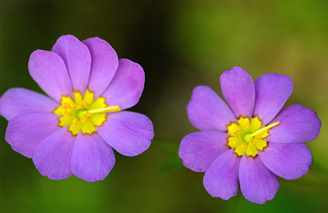 An Alabama cave that contains contains the largest documented wintering colony of federally listed endangered gray bats — about a million of them — has been struck by white nose syndrome (WNS), the US Fish and Wildlife Service reported yesterday. The good news is that WNS is not known to cause death in gray bats.
An Alabama cave that contains contains the largest documented wintering colony of federally listed endangered gray bats — about a million of them — has been struck by white nose syndrome (WNS), the US Fish and Wildlife Service reported yesterday. The good news is that WNS is not known to cause death in gray bats.
The infected bats found in the cave were tri-colored bats (aka eastern pipestrelles).
“With over a million hibernating gray bats, Fern Cave is undoubtedly the single most significant hibernaculum for the species,” said Paul McKenzie, Endangered Species Coordinator for the Service in the press release. “Although mass mortality of gray bats has not yet been confirmed from any WNS infected caves in which the species hibernates, the documentation of the disease from Fern Cave is extremely alarming and could be catastrophic. The discovery of WNS on a national wildlife refuge only highlights the continued need for coordination and collaboration with partners in addressing this devastating disease.”
Read the entire release, which has lots of details about the cave and how the infection was found, here.
In Canada, Environment Canada has committed to an additional $330,000 over four years for national coordination, surveillance and response to WNS. The US has had a national WNS coordinator (Jeremy Coleman, USFWS) for five years. The Canadian funds will go to the Canadian Cooperative Wildlife Health Centre.
“Canadian biologists and managers have done an incredible job responding to the threat of this disease with the resources they have,” said Katie Gillies, Imperiled Species Coordinator at Bat Conservation International in a letter to that organization’s members. “But hiring a formal WNS coordinator will certainly streamline those efforts and maximize their impact on this tragic disease. This is a very important step.
Read the Environment Canada press release here and here.
Photo: Gray bats, courtesy USFWS


 Bats move around a lot. Some bats migrate. Some bats move from summer or maternity roosts to winter hibernation caves. Finding out how bats move has suddenly become extremely important. White nose syndrome seems to be following the known patterns of bat movement. But just so little is known.
Bats move around a lot. Some bats migrate. Some bats move from summer or maternity roosts to winter hibernation caves. Finding out how bats move has suddenly become extremely important. White nose syndrome seems to be following the known patterns of bat movement. But just so little is known. Nineteen new species have been added to Nova Scotia’s list of species at risk, bringing the total listed in the province to 60, according to a
Nineteen new species have been added to Nova Scotia’s list of species at risk, bringing the total listed in the province to 60, according to a  Because of white nose syndrome (WNS), counting bats is more important than ever. In regions where WNS has already struck, wildlife researchers are tracking survival rates. In regions where it hasn’t struck, wildlife researchers are collecting baseline data.
Because of white nose syndrome (WNS), counting bats is more important than ever. In regions where WNS has already struck, wildlife researchers are tracking survival rates. In regions where it hasn’t struck, wildlife researchers are collecting baseline data. Bat Conservation International
Bat Conservation International Thirty bats from New York and Vermont, some of which were visibly infected with white nose syndrome (WNS), were moved to a specially-prepared military bunker in Maine to spend the winter. Nine bats survived, a higher percentage than would have been expected if they had been left in the wild. Those bats were returned to the locations where they were found.
Thirty bats from New York and Vermont, some of which were visibly infected with white nose syndrome (WNS), were moved to a specially-prepared military bunker in Maine to spend the winter. Nine bats survived, a higher percentage than would have been expected if they had been left in the wild. Those bats were returned to the locations where they were found.